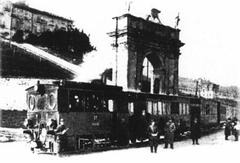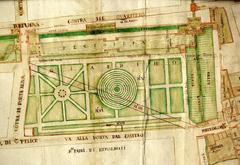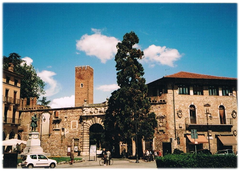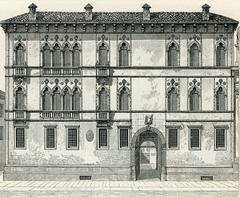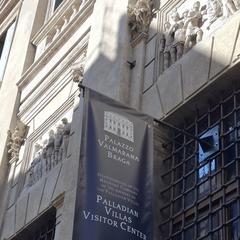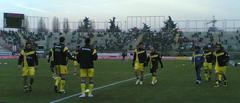Visiting Hours, Tickets, and Historical Sites of Palazzo Chiericati, Vicenza, Italy
Date: 23/07/2024
Introduction
Palazzo Chiericati in Vicenza, Italy, is a quintessential representation of Renaissance architecture, crafted by the illustrious Andrea Palladio. This architectural marvel, constructed between 1550 and 1680, stands as a testament to Palladio’s innovative use of classical elements and symmetrical design (Britannica). Originally commissioned by Count Girolamo Chiericati, the palazzo has evolved from a private residence to one of Vicenza’s most significant cultural institutions. Today, it houses the Museo Civico di Vicenza, featuring an extensive collection of Renaissance and Baroque art, including masterpieces by Tiepolo, Veronese, and Tintoretto (Musei Civici di Vicenza). This guide aims to provide comprehensive information on visiting Palazzo Chiericati, covering its historical and architectural significance, visitor details, travel tips, and more.
Table of Contents
History of Palazzo Chiericati
Origins and Construction
Palazzo Chiericati, located in Vicenza, Italy, is a masterpiece of Renaissance architecture designed by the renowned architect Andrea Palladio. The construction of the palazzo began in 1550 and was commissioned by Count Girolamo Chiericati, a prominent figure in Vicenza. The building was intended to serve as both a residence and a public space, reflecting the dual nature of many Renaissance structures.
Palladio’s design for Palazzo Chiericati was revolutionary for its time. The architect employed a tripartite division of the façade, which was a novel approach in residential architecture. The central section of the façade is accentuated by a loggia with Ionic columns on the ground floor and Corinthian columns on the upper floor. This design not only provided a grand entrance but also allowed for a covered public space, aligning with the building’s civic function.
Architectural Significance
The architectural significance of Palazzo Chiericati lies in its innovative use of classical elements. Palladio’s design was heavily influenced by ancient Roman architecture, particularly the works of Vitruvius. The use of columns, pediments, and a symmetrical layout are all hallmarks of classical architecture that Palladio adapted for a Renaissance context.
One of the most striking features of Palazzo Chiericati is its façade, which is divided into three sections by pilasters. The central section is further divided by a series of arches, creating a sense of depth and movement. This design was not only aesthetically pleasing but also functional, as it allowed for better light and ventilation within the building.
The interior of Palazzo Chiericati is equally impressive, featuring a series of grand halls and rooms adorned with frescoes and stucco work. The use of classical motifs in the interior decoration further emphasizes the building’s connection to ancient Roman architecture.
Historical Context
The construction of Palazzo Chiericati took place during a period of significant cultural and political change in Italy. The mid-16th century was marked by the rise of the Renaissance, a cultural movement that sought to revive the art and architecture of ancient Rome and Greece. This period also saw the emergence of powerful city-states, such as Venice and Florence, which played a crucial role in the patronage of the arts.
Vicenza, where Palazzo Chiericati is located, was part of the Republic of Venice during this time. The city was known for its thriving economy and vibrant cultural scene, making it an ideal location for the construction of grand architectural projects. The Chiericati family, who commissioned the palazzo, were prominent members of Vicenza’s aristocracy and played a significant role in the city’s political and cultural life.
Later Developments
After the death of Girolamo Chiericati, the palazzo remained in the family for several generations. However, it was not until the 19th century that the building underwent significant changes. In 1839, the palazzo was acquired by the city of Vicenza and was subsequently converted into a museum.
The transformation of Palazzo Chiericati into a museum marked a new chapter in its history. The building was restored and adapted to house a collection of art and artifacts, making it one of the most important cultural institutions in Vicenza. Today, the Museo Civico di Palazzo Chiericati is home to an extensive collection of Renaissance and Baroque art, including works by artists such as Veronese, Tintoretto, and Tiepolo.
Preservation and Restoration
The preservation and restoration of Palazzo Chiericati have been ongoing efforts to maintain the building’s architectural integrity and historical significance. In the 20th century, several restoration projects were undertaken to address structural issues and preserve the original frescoes and stucco work.
One of the most significant restoration projects took place in the early 2000s, when the building underwent a comprehensive renovation. This project aimed to restore the palazzo to its original condition, using historical records and architectural drawings to guide the restoration process. The project also included the installation of modern amenities to enhance the visitor experience while preserving the building’s historical character.
Influence and Legacy
Palazzo Chiericati has had a lasting impact on the field of architecture, influencing generations of architects and designers. Palladio’s innovative use of classical elements and his emphasis on symmetry and proportion have made the palazzo a seminal work in the history of architecture.
The building’s influence can be seen in numerous architectural projects around the world, particularly in the United States and England. Palladio’s designs were highly regarded by architects such as Inigo Jones and Thomas Jefferson, who incorporated Palladian principles into their own work. The legacy of Palazzo Chiericati is evident in the widespread adoption of Palladian architecture, which continues to be a popular style in both residential and public buildings.
Visitor Information
Tickets and Visiting Hours
- Opening Hours: Palazzo Chiericati is open Tuesday to Sunday from 9:00 AM to 5:00 PM.
- Ticket Prices: General admission is €7.00. Reduced rates are available for students, seniors, and groups. Free admission for children under 12.
- Purchase Tickets: Tickets can be purchased online or at the entrance. (Palazzo Chiericati Tickets)
Travel Tips and Nearby Attractions
- Best Time to Visit: Early morning or late afternoon to avoid crowds.
- Nearby Attractions: Teatro Olimpico, Basilica Palladiana, and Villa La Rotonda are all within walking distance.
- Photographic Spots: The grand staircase and two-tiered loggia offer excellent photo opportunities.
Special Events and Guided Tours
Palazzo Chiericati hosts various cultural events and exhibitions throughout the year. Guided tours are available and can provide a deeper understanding of the palazzo’s history and art collections. Visit the official website for the latest information on events and tours. (Community Events)
Accessibility
The palazzo is wheelchair accessible, with ramps and elevators available. For specific accessibility needs, contact the museum in advance.
Conclusion
Palazzo Chiericati stands as a beacon of Renaissance architecture. Whether you are an art enthusiast or history buff, this monument offers a glimpse into the grandeur of 16th-century Italy. Don’t forget to check the visiting hours and ticket information before planning your visit.
References
- Andrea Palladio, n.d., Britannica https://www.britannica.com/biography/Andrea-Palladio
- Museo Civico di Vicenza, n.d., Musei Civici di Vicenza https://www.museicivicivicenza.it/
- Palazzo Chiericati Tickets, n.d., Musei Civici di Vicenza https://www.museicivicivicenza.it/en/tickets/
- Community Events, n.d., Vicenza è https://www.vicenzae.org/en/
- Restoration Projects, n.d., Restauratori Senza Frontiere https://www.restauratorisenzafrontiere.com/en/palazzo-chiericati-vicenza/
